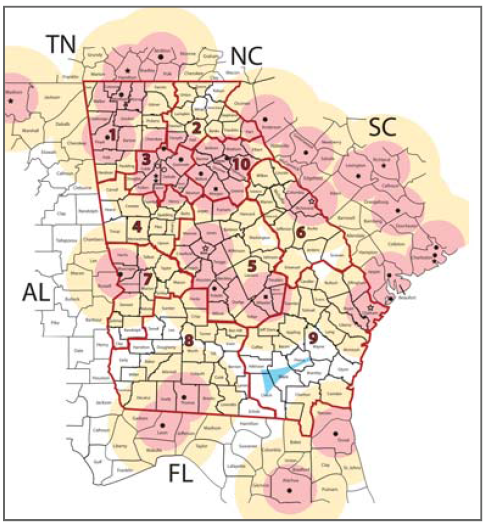Georgia Trauma Care Network Commission
Georgia Trauma Care Network Commission Adds Automatic Vehicle Location System to Save Lives

Georgia Trauma Care Network Commission Adds Automatic Vehicle Location System to Save Lives
Trauma is the leading cause of death in the United States, accounting formore than 160,000 fatalities each year and has been the leading cause ofdeath among children for decades. The fi rst 60 minutes after a trauma areknown as the “critical hour” for providing care.
BUSINESS CHALLENGE
The Georgia Trauma Care Network Commission (GTCNC) was established in2007 to address the insuffi cient number of trauma centers in Georgia and thelack of an organized and coordinated trauma system. The Georgia traumasystem is under development and will be comprised of integrated regionalsystems and plans and a centralized state-wide Trauma CommunicationsCenter (TCC) as a core component. The TCC will coordinate trauma systemactivities by maintaining and providing information on trauma centers’status and, when appropriate, on pre-hospital capabilities. This informationwill be used to ensure that patients meeting Trauma System Entry Criteria(TSEC) will have access to defi nitive trauma care at an appropriate levelof state-designated trauma center. A regionalized system approach toorganizing emergency care and hospital services will also benefi t disaster/terror preparedness, better manage emergency cardiac, stroke and surgerycases, and emergency patient fl ow to and from all hospitals within Georgia’shealthcare safety net.
“GTCNC needed to create a new public service that would assure anyoneseriously injured anywhere in the state would be transported quickly to atrauma center fully capable of providing the treatment necessary to savetheir life and enable their best possible recovery,” said Dennis W Ashley,M.D., Chair, Georgia Trauma Care Network Commission.
GTCNC contracted the Georgia Tech Research Institute (GTRI), a highlyregarded applied research and development organization solving some ofthe toughest problems facing government and industry across the nationand around the globe, to assist in the development of a state-of-the-arttrauma communications system for Georgia.
SIERRA WIRELESS INMOTION SOLUTION
The GTCNC, the Georgia Emergency Management Agency/HomelandSecurity (GEMA/HS) and GTRI created the Georgia EMS AVLS Program,a state-wide system to provide a display of ambulance positions and toassist the Georgia TCC to advise EMS agencies and hospitals of the closestappropriate designated trauma center to transport or transfer trauma systempatients. This system would also be a signifi cant asset to state emergencymanagement in a Mass Casualty Incident (MCI).
One of the goals of the program is to deploy an Automatic Vehicle LocationSystem (AVLS) to a majority of primary 911 Zone Providers across thestate, in order to provide the people in Georgia with a powerful traumacommunications center and mass casualty incident management asset.
After a competitive procurement process, GTRI selected an InMotionSolution for the state-wide GPS-based AVLS.
In Georgia, vehicle location information is also fed to the GEMA/HS StateOperations Center and other command centers for state-wide coordinationof EMS resources. Each ambulance has been equipped with a Garminpersonal navigation device (PND) and ambulance dispatches can beaccepted via the PND. In addition, the PNDs have been customized toenable two-way messaging so that medics can send preliminary informationback to dispatch centers.
The oMM provides each EMS agency with the ability to analyze informationfrom Gateways in the fi eld via a single, powerful management platformenabling agency personnel to centrally monitor ambulance locations, andmonitors vehicle diagnostics, devices and networks.
THE RESULTS: TESTED, TRUSTED AND PROVEN
During the fi rst phase of this deployment in August 2010, the GTCNCpiloted and purchased 200 oMGs for 27 individual EMS agencies in centralGeorgia. The oMGs also had to work with the GEMA/HS Geographic Tool forVisualization & Collaboration (GTVC), a geographic information system usedfor managing resources during responses to emergencies and homelandsecurity incidents.
In the second and third phases of this contract, GEMA/HS secured federalgrant funds to deploy an additional 350 oMGs to a further 48 GeorgiaEMS agencies, bringing the state-wide total to 550 vehicles across 75separate EMS agencies. The InMotion Solution enables improved resourcedeployment, vehicle management, dispatch, messaging and operations foreach EMS agency and provides GEMA/HS designated command centerswith a clearer picture of EMS operations for emergency response.
THE RESULTS: TESTED, TRUSTED AND PROVEN
In the future, the telecommunications platform provided under the AVLSprogram offers the potential to extend the capabilities of the hospital’semergency care center to the injury scene to improve triage, stabilization andtransfer/transport of all emergency care patients. Emergency cardiac and strokecases can be more effi ciently addressed with early analysis of ECGs, video andpatient care records by cardiologists and catheterization labs. The fourth phaseof the program added 200 oMGs across another 10-12 individual EMS agencies.
For individual EMS agencies, having a future-proof communications platformenables them to simply and cost-effectively deploy new applications thatsupport their mission, and offers them opportunities to add additional featuresand functionality such as:
BENEFITS IMPROVED RESPONSES:
LOWER COSTS:
IMPROVE OPERATIONS:
Trauma is the leading cause of death in the United States, accounting formore than 160,000 fatalities each year and has been the leading cause ofdeath among children for decades. The fi rst 60 minutes after a trauma areknown as the “critical hour” for providing care.
BUSINESS CHALLENGE
The Georgia Trauma Care Network Commission (GTCNC) was established in2007 to address the insuffi cient number of trauma centers in Georgia and thelack of an organized and coordinated trauma system. The Georgia traumasystem is under development and will be comprised of integrated regionalsystems and plans and a centralized state-wide Trauma CommunicationsCenter (TCC) as a core component. The TCC will coordinate trauma systemactivities by maintaining and providing information on trauma centers’status and, when appropriate, on pre-hospital capabilities. This informationwill be used to ensure that patients meeting Trauma System Entry Criteria(TSEC) will have access to defi nitive trauma care at an appropriate levelof state-designated trauma center. A regionalized system approach toorganizing emergency care and hospital services will also benefi t disaster/terror preparedness, better manage emergency cardiac, stroke and surgerycases, and emergency patient fl ow to and from all hospitals within Georgia’shealthcare safety net.
“GTCNC needed to create a new public service that would assure anyoneseriously injured anywhere in the state would be transported quickly to atrauma center fully capable of providing the treatment necessary to savetheir life and enable their best possible recovery,” said Dennis W Ashley,M.D., Chair, Georgia Trauma Care Network Commission.
GTCNC contracted the Georgia Tech Research Institute (GTRI), a highlyregarded applied research and development organization solving some ofthe toughest problems facing government and industry across the nationand around the globe, to assist in the development of a state-of-the-arttrauma communications system for Georgia.
SIERRA WIRELESS INMOTION SOLUTION
The GTCNC, the Georgia Emergency Management Agency/HomelandSecurity (GEMA/HS) and GTRI created the Georgia EMS AVLS Program,a state-wide system to provide a display of ambulance positions and toassist the Georgia TCC to advise EMS agencies and hospitals of the closestappropriate designated trauma center to transport or transfer trauma systempatients. This system would also be a signifi cant asset to state emergencymanagement in a Mass Casualty Incident (MCI).
One of the goals of the program is to deploy an Automatic Vehicle LocationSystem (AVLS) to a majority of primary 911 Zone Providers across thestate, in order to provide the people in Georgia with a powerful traumacommunications center and mass casualty incident management asset.
After a competitive procurement process, GTRI selected an InMotionSolution for the state-wide GPS-based AVLS.
In Georgia, vehicle location information is also fed to the GEMA/HS StateOperations Center and other command centers for state-wide coordinationof EMS resources. Each ambulance has been equipped with a Garminpersonal navigation device (PND) and ambulance dispatches can beaccepted via the PND. In addition, the PNDs have been customized toenable two-way messaging so that medics can send preliminary informationback to dispatch centers.
The oMM provides each EMS agency with the ability to analyze informationfrom Gateways in the fi eld via a single, powerful management platformenabling agency personnel to centrally monitor ambulance locations, andmonitors vehicle diagnostics, devices and networks.
THE RESULTS: TESTED, TRUSTED AND PROVEN
During the fi rst phase of this deployment in August 2010, the GTCNCpiloted and purchased 200 oMGs for 27 individual EMS agencies in centralGeorgia. The oMGs also had to work with the GEMA/HS Geographic Tool forVisualization & Collaboration (GTVC), a geographic information system usedfor managing resources during responses to emergencies and homelandsecurity incidents.
In the second and third phases of this contract, GEMA/HS secured federalgrant funds to deploy an additional 350 oMGs to a further 48 GeorgiaEMS agencies, bringing the state-wide total to 550 vehicles across 75separate EMS agencies. The InMotion Solution enables improved resourcedeployment, vehicle management, dispatch, messaging and operations foreach EMS agency and provides GEMA/HS designated command centerswith a clearer picture of EMS operations for emergency response.
THE RESULTS: TESTED, TRUSTED AND PROVEN
In the future, the telecommunications platform provided under the AVLSprogram offers the potential to extend the capabilities of the hospital’semergency care center to the injury scene to improve triage, stabilization andtransfer/transport of all emergency care patients. Emergency cardiac and strokecases can be more effi ciently addressed with early analysis of ECGs, video andpatient care records by cardiologists and catheterization labs. The fourth phaseof the program added 200 oMGs across another 10-12 individual EMS agencies.
For individual EMS agencies, having a future-proof communications platformenables them to simply and cost-effectively deploy new applications thatsupport their mission, and offers them opportunities to add additional featuresand functionality such as:
- Monitor the location and temperature of on-board medications.
- Track expensive mobile assets (e.g. stretchers and 12-lead EKG monitors).
- Improve driver behaviour and insurance costs.
- Reduce fuel costs.
- Improve vehicle life expectancy and unit hours with proactive maintenance.

BENEFITS IMPROVED RESPONSES:
- ECGs can be sent to the hospital with the press of one button, without a cell phone, PDA or external modem to reduce door-to-balloon times.
- EPCR can be sent with confi dence that records are transmitted from any location.
- Video connections can be set up for a telemedicine consultation with a specialist from a patient’s home or the road.
- Connectivity is maintained in rural areas.
LOWER COSTS:
- Patients can be tracked in a disaster situation.
- Communications consolidated over a single network for reduced mobile data communications costs.
IMPROVE OPERATIONS:
- Billing time and billing staff reduced.
- Emergency preparedness plans, drug databases, training materials, etc. can be accessed.
- Operations have detailed incident scene information (e.g. video).












